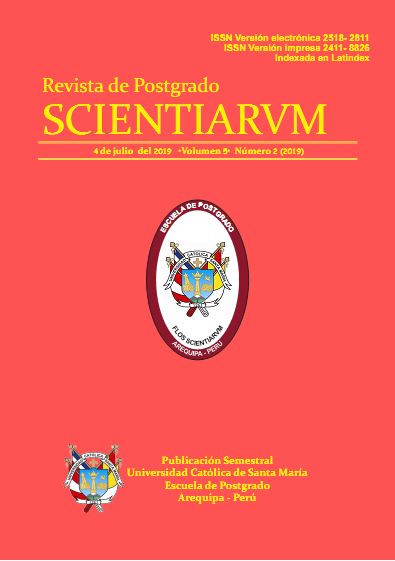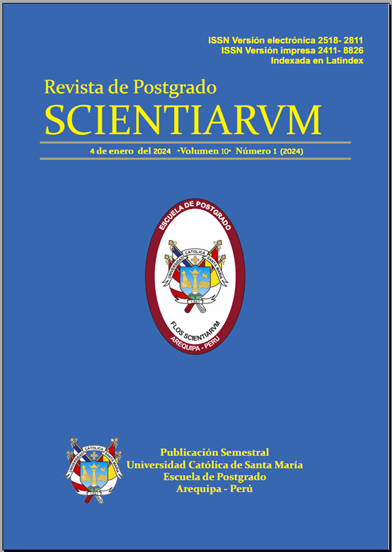ESTUDIO COMPARATIVO DEL CONTENIDO PROTEICO DE NUEVE VARIEDADES DE QUINUA (CHENOPODIUM QUINOA WILLD) CULTIVADAS EN TRES ZONAS AGROECOLÓGICAS DEL PERÚ
COMPARATIVE STUDY OF THE PROTEIN CONTENT OF NINE VARIETIES OF QUINOA (CHENOPODIUM QUINOA WILLD) GROWN IN THREE AGRO-ECOLOGICAL ZONES OF PERÚ
Ovidio Velasco1, Berly Cárdenas 1, Ricardo Abril1, Midwar Ancco2,
Rodolfo Ancco Loza3
- Universidad Católica de Santa María. Arequipa - Perú
- Universidad Nacional de San Agustín. Arequipa - Perú
- Universidad Nacional del Altiplano. Puno - Perú
RESUMEN: La quinua (Chenopodium Quinoa Willd) es un grano andino cuyo origen es región circunlacustre altiplánica del Perú y Bolivia. Se ha logrado domesticar distintas variedades de ancestros silvestres y con diversidad genética y capacidad de adaptación a diferentes condiciones agroecológicas. Debido a sus características nutritivas, como fuente proteica en los últimos años ha tomado gran interés mundial para su consumo directo e industrialización. El presente estudio tuvo como objetivo comparar el contenido proteico de nueve variedades de quinua, provenientes del Banco de Germoplasma de la Universidad Nacional del Altiplano de Puno: Salcedo INIA, Kankolla, Pasankalla, Blanca de Juli, Koytu, Huari Poncho, Choclito, Pandela Rosada, Chullpi Rojo, las mismas que fueron cultivadas en tres zonas agroecológicas del sur peruano y correspondientes a la campaña agrícola 2014: Puno, Arequipa y Camaná. Los análisis fueron realizados en el laboratorio de control de calidad de la Universidad Católica de Santa María de Arequipa, mediante el método de Kjeldahl modificado, y los resultados sometidos a la prueba estadística de ANOVA y Tukey. La variedad Huari Poncho, presento mayor porcentaje de proteínas con 13.95% en promedio a nivel de las tres zonas agroecológicas. La zona agroecológica de Arequipa es la que presenta mayor porcentaje de proteínas con 16.33% en relación a las otras dos zonas en estudio. Asi mismo existe un efecto de interacción altamente significativo para proteína entre los factores zona agroecológica y variedad de quinua.
Palabras Clave. Quinua, variedad, zona agroecológica, contenido proteico.
ABSTRACT: Quinoa (Chenopodium Quinoa Willd) is an Andean grain whose origin is the altiplanic region of Peru and Bolivia. It has managed to domesticate different varieties of wild ancestors and with genetic diversity and adaptability to different agro-ecological conditions. Due to its nutritional characteristics, as a source of protein in recent years it has taken great worldwide interest for its direct consumption and industrialization. The objective of this study was to compare the protein content of nine varieties of quinoa, from the Germplasm Bank of the National University of the Altiplano of Puno: Salcedo INIA, Kankolla, Pasankalla, Blanca de Juli, Koytu, Huari Poncho, Choclito, Pandela Rosada , Chullpi Rojo, the same ones that were cultivated in three agro-ecological zones of southern Peru and corresponding to the 2014 agricultural campaign: Puno, Arequipa and Camaná. The analyzes were performed in the quality control laboratory of the Catholic University of Santa Maria de Arequipa, using the modified Kjeldahl method, and the results submitted to the statistical test of ANOVA and Tukey. The variety Huari Poncho, presented a higher percentage of proteins with 13.95% on average at the level of the three agroecological zones. The agro-ecological zone of Arequipa has the highest percentage of proteins with 16.33% in relation to the other two zones under study. Likewise, there is a highly significant interaction effect for protein between the agroecological zone and quinoa variety factors.
Keywords. Quinoa, variety, agroecological zone, protein content.
Revista Seleccionada
Julio 2019 Volumen 5 - Número 2 P 31-35
DOI: 10.26696/sci.epg.0103
Enlaces
EDITORIAL
CIENCIAS SOCIALES Y HUMANIDADES
EL ANÁLISIS ECONÓMICO DEL DERECHO
EL IMPACTO DE LA MINERÍA EN LA ECONOMÍA DEL DEPARTAMENTO DE AREQUIPA
CIENCIAS BIOLÓGICAS Y DE SALUD


